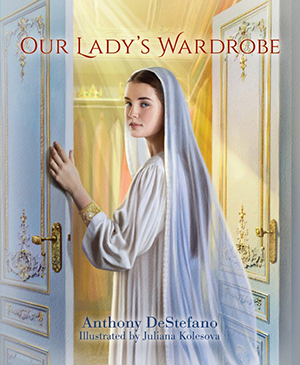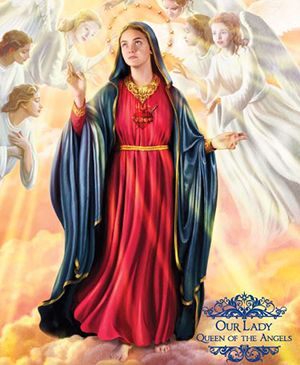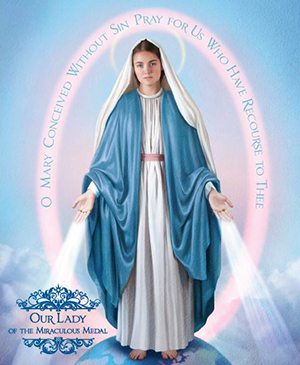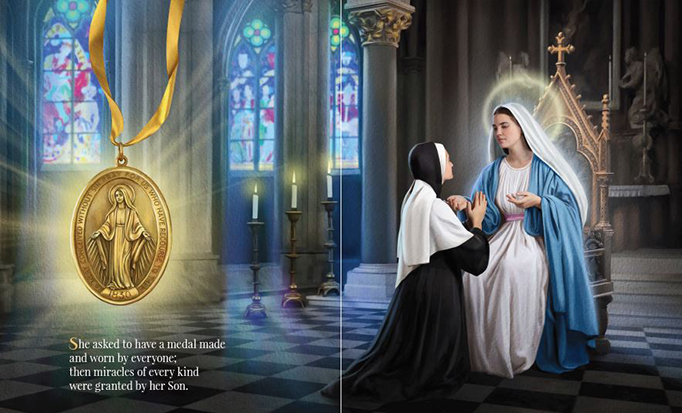Bestselling Author Turns to Our Blessed Mother
“I got the idea for Our Lady’s Wardrobe and I knew it was a book I had to write — because I knew it could help bring people to Christ.”


DeStefano has appeared on many national secular television and radio networks and has hosted both adult and children's programs for EWTN. He is vice-chairman of the board of Priests for Life, has worked with Father Frank Pavone for over 30 years, is a Knight of the Sovereign Military Order of Malta, and is a member of Legatus. DeStefano is also an avid private pilot — not that religion has anything to do with that, unless you count the faith it takes to overcome gravity.
While DeStefano and his wife were quarantined in their New Jersey home, in addition to praying, exercising, and writing a children’s book about St. Joseph (stay tuned), he answered a few questions for me.
What was the inspiration for Our Lady’s Wardrobe?

Even though Our Lady said and did such different things during her apparitions, she always has the same basic message: Follow my Son. Be close to Jesus. Listen to Jesus. Love Jesus.
So even though this book is about Mary, it is very Christ-centered. That’s why I’m not that worried about it being a “hard-sell” for Protestants. I hope this book will show our Protestant brothers and sisters that Catholics do not worship Mary. Rather, we love and revere her for her privileged role in salvation history — which is to help lead us to the one and only true Lord, Jesus Christ.
What do you love about this book?

As Catholics, we believe that when Mary’s time on earth was complete, she was assumed body and soul into Heaven. Right now in Heaven, Mary has a real, living breathing, vibrant, glorified body. She’s not a ghost. She’s living. And when she has appeared at various times in history — like at Lourdes or Fatima — the witnesses who saw her all said that she looked just like us — only more beautiful. I wanted to demonstrate this very important truth in my book. I didn’t want Our Lady to look like she does in all those 16th-century Renaissance and Baroque paintings (beautiful as those paintings are). Also, I wanted to show children that Our Lady is active in Heaven.
As Christians we don’t believe that our lives and activities end with bodily death. In Heaven right now the saints are extraordinarily busy. They’re not sitting around twiddling their thumbs! They’re trying to help us. That’s why it’s so important that we ask them to intercede for us. Life in Heaven is not less real than our earthly existence — it’s more real, more colorful, more exciting, more joyful. I think the illustrations in this book convey all that life.
What does the Blessed Mother mean to you?

It’s very easy for Protestants to misunderstand Catholics when they say they are “consecrated” to Mary. They want to know why we don’t just consecrate ourselves to Jesus. Consecration to Mary is merely a “route” or “way” or “method” to help us to be in fuller, more intimate union with Christ in a shorter period of time. After all, no one has ever had a closer relationship with Jesus than his mother. Real, authentic devotion to Mary always leads us to greater union with Jesus.
By way of example, I remember praying to God when I was in my teens and early twenties — even when I wasn’t sure that God existed — to help me get just one book published. It didn’t matter if I only wrote one book or if only 10 people read it. I just wanted to be a published author. For years, though, I couldn’t come up with any good ideas for books. But after I consecrated myself to Our Lady, I couldn’t stop the ideas from coming: ideas for books about Heaven and prayer and angels and atheism and hell and stars and donkeys and sheep and camels and seeds!
It was as if someone turned on a light switch in my head — a light that hasn’t gone out yet, thank goodness. And every single one of the books I wrote had one purpose — to help lead people to Christ. If consecration to Mary was really some form of idol worship, then surely my consecration would have resulted in 20 books about Mary. But as it is, Mary is hardly mentioned in any of my books. Our Lady likes to stay in the background, and I have always respected that. Except for this one time. I got the idea for Our Lady’s Wardrobe and I knew it was a book I had to write — because I knew it could help bring people to Christ.
Do you have a favorite Marian apparition?
All the approved apparitions are important. As someone who works full-time in the prolife movement, of course Our Lady of Guadalupe has great meaning. Mary was pregnant in the image she left for Juan Diego. That same image was responsible for helping convert a whole people to Christianity — and in the process, stop the barbaric ritual of child sacrifice. Well, that’s exactly the situation we are in today. We have a culture that desperately needs conversion, and we must end the ritual sacrifice of children known as abortion.
Our Lady of Fatima is also hugely important for today. When Our Lady appeared in Portugal to the three shepherd children — Lucia, Jacinta and Francisco — the world was on the brink of war. We were at the beginning of a century unmatched in the annals of time for its violence and murder. That’s why Our Lady performed that great miracle of the Sun — to show that God is all-powerful, that the SON is all-powerful, and that we need to listen to him. Well, we stand at beginning of another new century today, and the titanic battle of good versus evil couldn’t be more clear, with the vicious war being waged by the culture upon traditional Christian values and especially the institution of the family. We need another miracle.
If you’re asking me, however, what apparition has the most personal meaning for me, I would have to say the one that took place in Lourdes, France. Ever since I saw the movie, The Song of Bernadette as a little boy, I’ve been fascinated by the story of Lourdes. I finally got to make a visit there a few years ago, in the dead of winter, when all the hotels were closed and there were practically no tourists. For three days, my wife and I would get up early in the morning — around 5 a.m. — and in the dark make our way through the narrow, winding streets to the sanctuary area.
Even though we were bundled up in heavy coats and hats and gloves and thick scarves, we were shivering. But it didn’t matter — we had the grotto all to ourselves. I have many strange and beautiful memories of that time. Every morning we were able to go to the exact location where Bernadette first saw Our Lady (the spot is clearly marked); we would kneel there in the dark, holding a candle and saying our rosary — just as Bernadette did — while looking up the whole time at the softly lit grotto and the white statue of Mary. The only sound we could hear was the swift moving current of the river Gave behind us.
Afterward, we would go to early morning Mass in the crypt of the huge basilica, above the grotto. Then we would try to find somewhere in the deserted town to have breakfast and especially a steaming hot café crème. It was a wonderful time, and to this day I feel Our Lady was taking special care of us and giving us a unique gift. So yes, even though I recognize the importance of other apparitions, and even though I dedicated my book to Our Lady of the Most Holy Rosary, I do have a personal devotion to Our Lady of Lourdes.
DeStefano has two other books coming out this year, the adult Christian Hell: A Guide on June 16 and for children, The Grumpy Old Ox, at Christmas.

- Keywords:
- mary


















